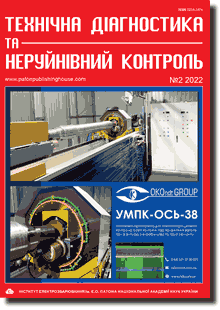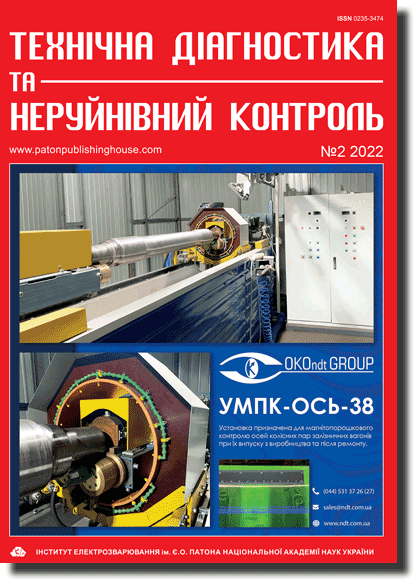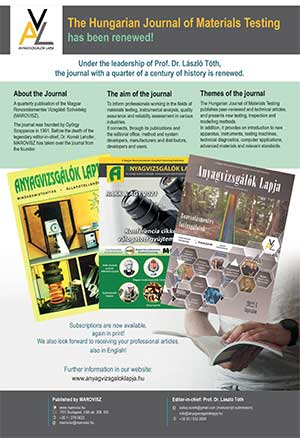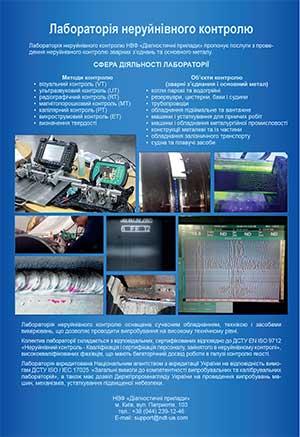| 2022 №02 (02) |
DOI of Article 10.37434/tdnk2022.02.03 |
2022 №02 (04) |

"Tekhnichna Diahnostyka ta Neruinivnyi Kontrol" (Technical Diagnostics and Non-Destructive Testing) #2, 2022, pp. 20-23
Automation of thermal non-destructive testing process by applying the method of complexing thermographs
D.V. Storozhik, A.G. Protasov, O.V. Muraviov, V.F. Petrik, D.V. Petrenko
National Technical University of Ukraine «Igor Sikorsky Kyiv Polytechnic Institute». 37 Peremohy Ave., 03056, Kyiv, Ukraine. E-mail: a.g.protasov@gmail.com
Experimental studies were conducted to improve the quality of thermograms obtained by thermal non-destructive testing. The method of image complexation based on wavelet transform using neural networks is applied. To determine the shape of the defect, a neural network was used, the architecture of which had layers that implement the convolution operation. Preliminary training of the neural network was implemented on the basis of a large number of thermal images of test objects that imitate various defects. The use of complex thermograms as input data for the neural network has signifi cantly reduced the error in determining the class of the defect in the image. The developed computer program for thermogram processing allows automating the process of thermal testing and increasing the probability of correctly determining the presence and form of the defect in the tested object. Ref. 9, Fig. 5.
Keywords: thermal non-destructive testing, image complexation, neural networks
Received:18.02.2022
References
1. Protasov, A. (2018) Active infrared testing of composite using 3D computer simulation. Int. J. of Technology, 9(3), 632-641. https:doi.org/10.14716/ijtech.v9i3.218. https://doi.org/10.14716/ijtech.v9i3.2182. Galagan, R., Muraviov, A., Tomashuk, A. (2019) A model for recovering a series of images from a smeared image in solution of problem of high precision measurement of diameter and temperature of radiation objects. In: Proc. of 4th Int. Sci.-Tech. Conf. on Theoretical and Applied Aspects of Radio Engineering, Equipment and Computer Technologies (to 80th Anniversary of Prof. Ya.I. Prots), 169-171.
3. Qu, Z., Jiang, P., Zhang, W. (2020) Development and application of infrared thermography non-destructive testing techniques. Sensors, 20(14), 3851. https://doi.org/10.3390/s20143851
4. Storozhyk, D.V., Muraviov, O.V., Protasov, A.G. et al. (2020) Complexing of multispectral images as a method of increase of their informative in binary segmentation. Naukovi Visti KPI, 2, 82-87 [in Russian]. https://doi.org/10.20535/kpi-sn.2020.2.197955
5. Thirunavukkarasu, S., Rao, B.P.C., Soni, A.K. et al. (2012) Comparative performance of image fusion methodologies in eddy current testing. Research J. of Applied Sci., Engineer. and Technol., 4(24), 5548-5551.
6. Zhijun, Wang, Ziou, D., Armenakis, C. et al. (2005) A comparative analysis of image fusion methods. IEEE Transact. on Geoscience and Remote Sensing, 43(6), 1391-1402. https://doi.org/10.1109/TGRS.2005.846874
7. Hamza, A.B., He, Y., Krim, H. et al. (2005) Multiscale approach to pixel-level image fusion. Integr. Comput. Aid. Eng., 12(2), 135-146. https://doi.org/10.3233/ICA-2005-12201
8. Sabuncu Mert Rory. (2006) Entropy based image registration. In: Ph.D. dissertation, Department of Electrical Engineering, Princeton University.
9. Shensa, M.J. (1992) The discrete wavelet transform: wedding the a Trous and Mallat algorithms. IEEE Transact. on Signal Processing, 40(10), 2464-2482. https://doi.org/10.1109/78.157290
Advertising in this issue:
The cost of subscription/purchase order journals or individual articles
| Journal/Currency | Annual Set | 1 issue printed |
1 issue |
one article |
| TPWJ/USD | 384 $ | 32 $ | 26 $ | 13 $ |
| TPWJ/EUR | 348 € | 29 € | 24 € | 12 € |
| TPWJ/UAH | 7200 UAH | 600 UAH | 600 UAH | 280 UAH |
| AS/UAH | 1800 UAH | 300 UAH | 300 UAH | 150 UAH |
| AS/USD | 192 $ | 32 $ | 26 $ | 13 $ |
| AS/EUR | 180 € | 30 € | 25 € | 12 € |
| SEM/UAH | 1200 UAH | 300 UAH | 300 UAH | 150 UAH |
| SEM/USD | 128 $ | 32 $ | 26 $ | 13 $ |
| SEM/EUR | 120 € | 30 € | 25 € | 12 € |
| TDNK/UAH | 1200 UAH | 300 UAH | 300 UAH | 150 UAH |
| TDNK/USD | 128 $ | 32 $ | 26 $ | 13 $ |
| TDNK/EUR | 120 € | 30 € | 25 € | 15 € |
AS = «Automatic Welding» - 6 issues per year;
TPWJ = «PATON WELDING JOURNAL» - 12 issues per year;
SEM = «Electrometallurgy Today» - 4 issues per year;
TDNK = «Technical Diagnostics and Non-Destructive Testing» - 4 issues per year.









